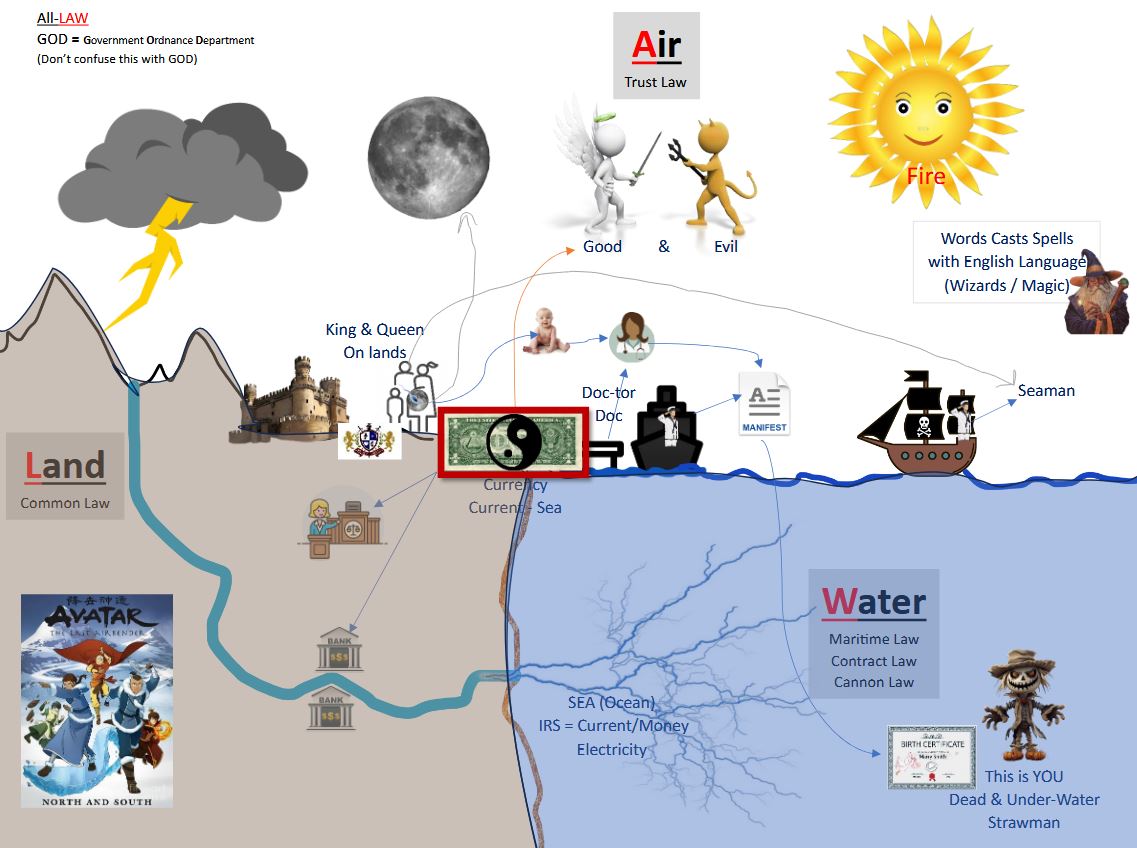
From Water to Paper: vessels, titles, currency… and the people who power it

Out on open water, vessels carry cargo. A seaman keeps watch; a bill of lading lists what’s aboard. When the ship docks, port officers inspect the papers and value crosses the threshold—from sea to land—recorded, receipted, priced. Everything in motion follows a current. Electricity moves by positive and negative, tides by flood and ebb, ledgers by credit and debit. Paper trails the motion: endorsements, receipts, tallies. In money, the current is called currency, a river guided by banks along the banks, flowing toward the great sea of national finance.
Now transpose the picture to family life. Two people set sail together. In time, the man’s semen reaches the woman’s moon-timed egg. A spark takes hold—some call it miracle. During labor, the child moves through a canal, and the Doc-tor—the keeper of documents—delivers the precious cargo onto land. Paper follows life: a Birth Certificate is made and entered; later a Social Security Number is assigned so the new life can be seen by the counting houses, indexed in ledgers, routed through the systems that pay and charge.

Here the story sharpens. People are taught to speak as persons, to sign as if they were corporations, to wear the citizen mask tied to corporate jurisdictions. Banks are for corporations; corporations are for paper persons; and the living source is told it is the debtor in a game whose credit runs on its own time, energy, and promise. Turn the wheel and the picture inverts: the living people are the full faith and credit of the United States based on House Joint Resolution 192 (1933)—the engine of the whole arrangement. A shift in the early 1930s changed how paper is measured and claims are balanced; the living became the collateral current that keeps every light on. What we read, write, and hear turns the helm—narratives that train minds to accept debt-first living, to labor in public peonage to money as master/slavery called debt bondage, to chase one more due date, one more note, one more fee.
Back to water. If no one claims title to the paper identity, the tale says it drifts—abandoned at sea—after the age of majority. Two of you walk: the paper straw-self under water (insolvent on paper) and the living man or woman upright on land. Hence the feeling of being under water when broke; hence the sense of the walking dead—moving, but not standing in honor. Above is Air (trusts, oath, faith, higher jurisdiction). Beneath is Land (common dealings, community, substance). Between is Water (maritime, carriage, bills of lading). Three lenses for where life meets paper meets money—and who is steering.
At this point the story pauses and introduces an old maxim whispered like a caution at the gangway—the wizard’s first rule: people are easily led by motivation. Give a compelling cause and crowds will believe almost anything, true or false. If the purpose feels larger than the truth, truth gets ignored. Words cast spells on the mind of the living; stories steer decisions; names and signatures launch ships. The wise helmsman minds the spell he speaks, the paper he signs, the purpose he serves.
Then comes a scene on the sea at night. A figure walks upon the water, and another climbs out to follow. He walks, then looks down through the surface, sees the graves beneath—the debts, the dread—and begins to sink. The first takes his hand and sets him back on the waves. Read as a metaphor: learn the LAW—Land, Air, Water—so you’re not dragged under by currents you cannot name. Keep your eyes on the higher rule; do not let fear or confusion pull you below. The lesson isn’t about escaping the sea; it’s about mastering your footing upon it.

Anchored through all of this is a claim handed down in scripture and oath: the Bible is the law—the law of the land, the air, and the water—a charter of duties and remedies, a grammar of promises and performance. On Land, it speaks to honest weights, neighbor, boundary stones, keeping your word. In the Air, it speaks to faith, trusteeship, oath, and equity—what cannot be seen but binds men stronger than iron. Upon the Water, it speaks to voyage and storm, rescue and salvage, to commerce tempered by conscience. Read this way, the Book is a pilot chart. It teaches how to set capacity, choose venue, and aim purpose; it instructs the tongue that names, the hand that signs, the heart that intends.
So the teaching circles back to the dock. Paper follows life—not the other way around. Titles, accounts, and offices exist to record the value people create, not to eclipse it. If people are the current, they are also the currency that animates every ledger. Speak and sign with clarity about capacity (living man or woman vs. paper person), choose the proper venue (land/air/water), and fix your purpose (creditor conduct rather than debtor reflex). Bring the ship to dock with your own hands, present your papers as master of the cargo, and the current begins to obey the helmsman again.

And should the crowd shout a purpose so loud that truth is drowned, remember the maxim and steady the helm. The sea is wide, the banks are high, the storms come and go; yet those who know their standing, their forum, and their aim can do the impossible thing—like walking upon the water—because they have learned which law they stand in, which words they sail under, and which port they intend to reach.
End of Story
Listen to the story Here
Heard Enough?

A visual map of L-A-W—Land, Air, Water—and their metaphors.
Land (left): mountains, a castle with “King & Queen,” a clerk/recorder, banks, and a river flowing to the sea, labeled “Common Law.”
Air (top): moon, lightning, sun (“Fire”), and “Good & Evil,” plus a note that “Words cast spells,” pointing to language and intent.
Shoreline: doctor (Doc), ship and “Manifest,” and a money/Yin-Yang block marking currency/current at the boundary.
Water (right): open sea with ships and “Seaman,” branching electric-like currents (IRS = Current/Money/Electricity), a panel for Maritime/Contract/Canon Law, and a birth certificate with a “strawman” figure (“Dead & Under-Water”).

Foundational terms (with public sources)
“United States” (for the Federal Debt Collection Procedures Act only)
“ ‘United States’ means—(A) a Federal corporation; (B) an agency, department, commission, board, or other entity of the United States; or (C) an instrumentality of the United States.”
(This definition applies only “as used in this chapter,” 28 U.S.C. §§ 3001–3308.)“Person” (same chapter as above)
“ ‘Person’ includes a natural person…, a corporation, a partnership, an unincorporated association, a trust, or an estate, or any other public or private entity….”
(Again, this is chapter-scoped.)“Person” (Internal Revenue Code – applies throughout Title 26)
“The term ‘person’ shall be construed to mean and include an individual, a trust, estate, partnership, association, company or corporation.”
“Corporation” (Internal Revenue Code)
“The term ‘corporation’ includes associations, joint-stock companies, and insurance companies.”
“United States” and “State” (Internal Revenue Code)
“‘United States’ when used in a geographical sense includes only the States and the District of Columbia.” (a)(9)
“‘State’ shall be construed to include the District of Columbia.” (a)(10)“United States person” (tax context)
A “United States person” includes a citizen or resident of the United States, domestic partnership or corporation, domestic estate, and certain trusts.
“Citizen of the United States” (Nationality Act)
Lists persons who are citizens at birth (e.g., born in the States, certain birth abroad to U.S. parent(s), etc.).
False claim of U.S. citizenship (criminal statute)
“Whoever falsely and willfully represents himself to be a citizen of the United States shall be fined… or imprisoned not more than three years, or both.”
Nonresident alien individual (Treasury regulation)
The regulations classify alien individuals as resident or nonresident for tax; nonresidents are taxed only on U.S.-source categories described in the Code. (Useful if you’re mapping residency status—not a corporate status.)
Legal tender (money law)
“United States coins and currency (including Federal Reserve notes…) are legal tender for all debts, public charges, taxes, and dues.” (Explains tender, not corporate status.)
About House Joint Resolution 192 (1933) / Public Resolution 73-10
Congress invalidated “gold clauses” in contracts so obligations would be payable in legal-tender dollars rather than a fixed amount of gold. The Supreme Court addressed it in the Gold Clause Cases (e.g., Norman v. Baltimore & Ohio R. Co., 294 U.S. 240 (1935)). This resolution did not convert people into corporations or create secret accounts; it was a monetary policy move.
18 U.S. Code § 912 - Officer or employee of the United States
Whoever falsely assumes or pretends to be an officer or employee acting under the authority of the United States or any department, agency or officer thereof, and acts as such, or in such pretended character demands or obtains any money, paper, document, or thing of value, shall be fined under this title or imprisoned not more than three years, or both.
18 U.S. Code § 914 - Creditors of the United States
Whoever falsely personates any true and lawful holder of any share or sum in the public stocks or debt of the United States, or any person entitled to any annuity, dividend, pension, wages, or other debt due from the United States, and, under color of such false personation, transfers or endeavors to transfer such public stock or any part thereof, or receives or endeavors to receive the money of such true and lawful holder thereof, or the money of any person really entitled to receive such annuity, dividend, pension, wages, or other debt, shall be fined under this title or imprisoned not more than five years, or both.
Quick glossary
United States (28 U.S.C. ch. 176 context): includes a federal corporation and federal agencies/instrumentalities—only for that chapter.
United States (26 U.S.C. tax context): geographically, the States and D.C.
State (26 U.S.C. tax context): includes D.C.
Person (Title 26): any individual or entity (trust, estate, partnership, association, company, corporation).
Corporation (Title 26): includes associations, joint-stock companies, insurance companies.
U.S. person (Title 26): citizen/resident individuals and domestic entities.
Citizen of the United States (Title 8): who is a citizen at birth.
Legal tender (Title 31): U.S. coins/currency are legal tender for debts, public charges, taxes, dues.
Song - I am a Protector
“Not for money, but for truth—we stand in the right law, guard our families and the Republic, and rise together so legacy outruns profit.”
Protect your future—today.
Use a UNA (Unincorporated Nonprofit Association) and a Revocation of Election (ROE) to take control.
Reach Jason or Albert to learn more.


